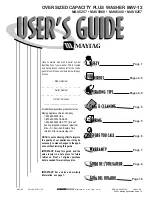
.8.
Wash Cycle Table
GB
Cycle
Button
Button
Cycle Selection
Information
Description of
Cycle
Deter-
gent
Rinse
Aid
Very dirty dishes, pots and
pans (not to be used with
delicate items).
Very dirty dishes, pots and
pans. (Not to be used with
delicate items)
Normally dirty dishes, pots
and pans. Standard daily
cycle.
For dishes that need to be
rinsed and dried only.
Pre-wash of dishes, pots and
pans while waiting for the load
to be completed after the subse-
quent meal.
Pre-wash with hot water.
Extended wash at 63
K
Rinse with cold water.
Rinse with hot water
K
Drying.
Pre-wash with hot water.
Extended wash at 53
K
Rinse with cold water
K
Rinse with hot water
K
Drying.
Extended wash at 63
K
Rinse with cold water.
Rinse with hot water
K
Drying.
Rinse with cold water.
Rinse with hot water at 63
K
Drying.
Short cold wash to prevent
food residue from drying on
the dishes
K
Normally dirty dishes, pots
and pans. Standard daily
cycle.
Extended wash at 53
K
Rinse with cold water.
Rinse with hot water
K
Drying.
For dishes that need to be
rinsed and dried only.
Rinse with cold water.
Rinse with hot water at 53
K
Drying.
Heavy Duty
Normal Wash
Rinse
Soak
Normal Wash
Rinse
Rinse
For dishes that need to be
rinsed and dried only.
Rinse with cold water.
Rinse with hot water at 58
K
Drying.
Normally dirty dishes, pots
and pans. Standard daily
cycle.
Extended wash at 58
K
Rinse with cold water.
Rinse with hot water
K
Drying.
Very dirty dishes, pots and
pans. (Not to be used with
delicate items)
Pre-wash with hot water.
Extended wash at 58
K
Rinse with cold water
K
Rinse with hot water
K
Drying.
Rapid Wash
Economic,fast cycle to be used to
on not very dirty dishes right after
they are used. No drying cycle.
Short wash at 60
.
Cold rinse.
Heavy Duty
Heavy Duty
Normal Wash
Rapid Wash
Rapid Wash
Economic,fast cycle to be used to
on not very dirty dishes right after
they are used. No drying cycle.
Economic,fast cycle to be used to
on not very dirty dishes right after
they are used. No drying cycle.
Short wash at 55
.
Cold rinse.
Short wash at 50
.
Cold rinse.
30g
30g
30g
25+5g
ERF
30g
30g
15g
15g
15g
(EN50242)






























